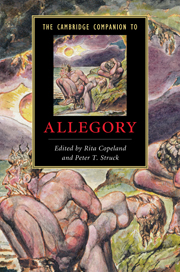Book contents
- Frontmatter
- Introduction
- Part I: Ancient foundations
- Part II: Philosophy, theology, and poetry 200 to 1200
- Part III: Literary allegory: philosophy and figuration
- 8 Allegory in the Roman de la Rose
- 9 Dante and allegory
- 10 Medieval secular allegory: French and English
- 11 Medieval religious allegory: French and English
- 12 Renaissance allegory from Petrarch to Spenser
- 13 Protestant allegory
- 14 Allegorical drama
- Part IV: The fall and rise of allegory
- Further reading
- Index
8 - Allegory in the Roman de la Rose
from Part III: - Literary allegory: philosophy and figuration
Published online by Cambridge University Press: 28 January 2011
- Frontmatter
- Introduction
- Part I: Ancient foundations
- Part II: Philosophy, theology, and poetry 200 to 1200
- Part III: Literary allegory: philosophy and figuration
- 8 Allegory in the Roman de la Rose
- 9 Dante and allegory
- 10 Medieval secular allegory: French and English
- 11 Medieval religious allegory: French and English
- 12 Renaissance allegory from Petrarch to Spenser
- 13 Protestant allegory
- 14 Allegorical drama
- Part IV: The fall and rise of allegory
- Further reading
- Index
Summary
The thirteenth-century French verse Roman de la Rose involves striking new developments in the deployment of various allegorical constructs and procedures, within the context of a self-conscious and innovative expansion of dominant vernacular literary discourses, both lyric and narrative. It is necessary to stress at the outset the Rose's unique status in the medieval French literary corpus - in terms of authority, of prestige, and of influence. Not only does it exist in a greater number of manuscripts (nearly three hundred) than any other single work from this corpus, but it generated a remarkable number of poetic, philosophical, theological and political responses in a variety of key European cultural contexts: Italian, English, and Dutch, as well as French. In all of these contexts, it is particularly significant that the Rose is a work by two authors: the “courtly” Guillaume de Lorris, whose romance (of about 4,000 lines, apparently incomplete) dates from c. 1225-30; and the “clerkly” Jean de Meun, who self-consciously continued and completed his predecessor's kernel text between c. 1270 and 1280 with an additional 18,000 lines. It was only the conjoined Rose text of which Jean was the architect that succeeded so spectacularly (and so quickly) in dominating the French vernacular literary scene.
- Type
- Chapter
- Information
- The Cambridge Companion to Allegory , pp. 119 - 127Publisher: Cambridge University PressPrint publication year: 2010



